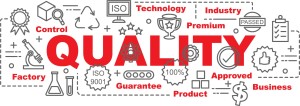Have you ever bought something multiple times, only to find out it changed or had a quality issue? Frustrating right?! In order to keep customers happy (and coming back), you need consistency and continuous improvement of your product’s core manufacturing, assembly and packaging. Quality controls and processes, tracked real-time via software systems, are the key.
Key considerations
The quality of your product is only as good as the processes and controls behind it. These controls ensure cost effective and timely production, consistent quality levels and customer satisfaction. Key considerations include:
Compliance
Ensure continued compliance to industry standards like ISO and FDA. Without this compliance, you can incur infractions, fines, stoppages or even losing your certifications.
Risk mitigation
Reduce risks like not meeting production orders, quality standards and consistency, not to mention physical risks to your equipment and labor.
Operational necessities
Keep up with production levels efficiently while maintaining standards.
Continuous improvement
Document and analyze data collected for continuous improvement. This includes proactive solution-building if an issue arises, or revamping processes after a project review is completed.
When and how often
Quality and production processes and controls should be reviewed and evaluated on an ongoing basis – from the initial kick-off of a project, throughout the production, and post-completion. This is a collaborative effort by everyone involved in the production of your product, including internal design teams, manufacturers, contract assembly and packaging vendors, and more. Throughout production, QA processes should be layered, meaning performed by multiple groups of people like quality control managers, then auditors, and finally by an independent auditing firm. This ongoing effort ensures that problems are identified before or exactly when they happen, not after the entire run.
Five steps to evaluate a potential new process or control
Follow these five steps to determine when/if to add a new quality process or control.
- Gather current data
- Analyze data
- Complete a risk analysis
- Assess timeliness
- Determine feasibility, viability and sustainability
Using technology and software
Software systems allow for real-time visibility and communication around all facets of your product’s production. Most software is now cloud-based, ensuring access practicably 100% of the time. With this software you can track ingredients, processes, and production levels; communicate quickly; and be alerted to any issues as they happen. This access and visibility helps you solve quality issues faster, if they arise.
In conclusion
We’ve just scratched the surface of this vital topic. To discuss quality processes and controls in detail, contact us to speak to a member of our team.

